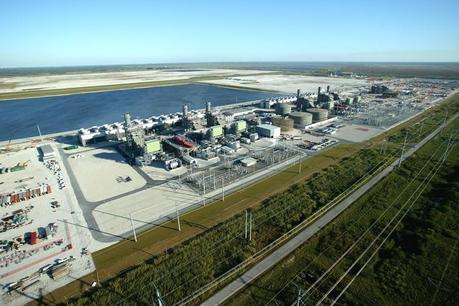by Eileen Soler / the Seminole Tribune

The West County Energy Center hard fought by Everglades Earth First! from 2006-2008. It is said that the proposed Hendry County Energy center is to be a carbon copy of this plant.
BIG CYPRESS — Plans are in the works for Tribal members, environmental activists and all friends of nature to let their feet do the talking against a massive Florida Power & Light (FPL) plant that could be built on property a stone’s throw from the Big Cypress Reservation.
Carrying banners, more than 200 who oppose the plant will begin walking April 17 from Big Cypress Reservation to the seat of Hendry County government, the LaBelle Courthouse Complex at 25 E. Hickpoochee Ave.
Demonstrators hope to bring widespread attention and support for the Seminole Tribe v. Hendry County case set to be heard at the courthouse April 21. The case concerns land zoning changes to the FPL property that could clear a path for construction of one of the largest gas powered plants in the country.
Activists, elders, traditionals and Tribal department heads gathered Feb. 7 at the Frank Billie Office on Big Cypress to strategize for the roughly 70-mile walk. They are driven by science-based predictions that the plant will bring disastrous consequences to the environmentally sensitive land and end the delicate balance of nature, history and culture for the Seminoles.
“We need to be highly visible,” said Samuel Tommie, an Everglades advocate, film artist and Tribal member who was born in Trail and raised in Big Cypress. “We have to think of our future generations.”
Environmental groups including Earth First!, Sierra Club, Audubon Society, South Florida Wildlands Association and the Everglades Sawgrass Warriors are already on board for the walk.
The proposed plant, on 2,300 acres that butt the reservation’s north boundary, will be a duplicate of the West County Energy Center in Palm Beach County with 15-story high steaming smokestacks, rows of transmission towers and several large cooling water pools.
The site sits on proven habitat for several threatened or endangered species, including the crested caracara bird, snail kite bird, eastern indigo snakes and Florida panther. Further, the property and surrounding land is known by Tribal historians to hold relics and artifacts that date back to Native ancestors.
“At the end of the day, the plant will affect all of us,” said Big Cypress Councilman Mondo Tiger.
According to a Department of Environmental Protection report, the Palm Beach plant leads the region in producing greenhouse gasses – the main source of global warming. In 2012 alone, it discharged into the air 9.1 million metric tons of carbon dioxide – the industrial gas most responsible for climate change.
The plant would require 22 million gallons of water daily to be extracted by force from the Florida aquifer, Hendry County’s main source of water.
Tommie, whose short environmental film In Our Creator’s Hands has been shown at Florida Gulf Coast University and Florida International University, said he knows what is at risk firsthand.
“It’s unbelievable to even imagine that there would be a power plant where I see the trees, the endangered birds and deer crossing the road. I know panthers go there to sleep during the day,” he said. “If fighting means educating people to get them to understand that the plant can’t happen, then I am fighting.”
Shannon Larsen, of Ancient Trees, suggested that walkers plan stops along the way for “townhouse meetings” to bring awareness to people in neighborhoods.
“We need to draw in citizens and listen to their issues, as well,” Larsen said.
Plans will include staged stopping points for meal breaks and overnight resting. Walking time will be divided into manageable increments no longer than 20 miles per day.

